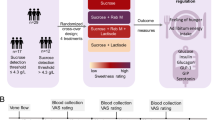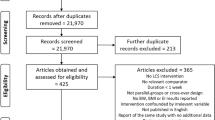Abstract
OBJECTIVE: To examine the effects of a sugar-only (SO) beverage vs one containing a mixed-nutrient (MN) composition on energy expenditure and feelings of hunger and satiety.
HYPOTHESIS: A beverage containing a mixed macronutrient composition will lead to greater thermic effect of food and feelings of fullness than an isocaloric beverage containing only sugar.
RESEARCH METHODS AND PROCEDURES: Adults were randomly assigned to receive a 2510 kJ (600 kcal) SO liquid formula followed by an isovolumic, isoenergetic, MN liquid formula with an energy distribution of 17% protein, 67% carbohydrates as sucrose and corn syrup solids, and 16% fat, or vice versa, in a crossover design. The carbohydrate source in the two beverages was identical: 1:1 ratio of sucrose and corn syrup solids (25 dextrose equivalents). The thermic response was calculated as the 7 h deviation from resting metabolic rate (RMR). Subjects provided hunger/satiety ratings and other related information by visual analog scales at regular intervals throughout the study period.
RESULTS: In all, 20 subjects completed the protocol; one was removed from the thermic effect analysis due to discrepant RMRs. Following beverage ingestion, SO and MN liquid meals produced 7 h thermic effects of (X±s.e.m.) 274.1±27.6 kJ (65.5±6.6 kcal) and 372.0±33.9 kJ (88.9±8.1 kcal), respectively, resulting in a significant (P<0.01) difference between meals (Δ=97.9±35.1 kJ [23.4±8.4 kcal]). Analysis of satiety ratings using area under the curve analysis showed greater feelings of satiety (P<0.05) with MN compared to SO consumption. Also, subjects felt that they could eat less (P<0.05) after consumption of the MN vs SO beverage.
DISCUSSION: In comparison to MN beverages, SO beverages are associated with a relatively high-energy retention without accompanying subjective hunger/fullness compensations, suggesting a basis for their role in long-term unintentional weight gain in healthy adults.
This is a preview of subscription content, access via your institution
Access options
Subscribe to this journal
Receive 12 print issues and online access
$259.00 per year
only $21.58 per issue
Buy this article
- Purchase on Springer Link
- Instant access to full article PDF
Prices may be subject to local taxes which are calculated during checkout


Similar content being viewed by others
References
Nielsen SJ, Siega-Riz AM, Popkin BM . Trends in energy intake in US between 1977 and 1996: similar shifts seen across age groups. Obes Res 2002; 10: 370–378.
Ludwig DS, Peterson KE, Gortmaker SL . Relation between consumption of sugar-sweetened drinks and childhood obesity: a prospective, observational analysis. Lancet 2001; 357: 505–508.
DiMeglio DP, Mattes RD . Liquid versus solid carbohydrate: effects on food intake and body weight. Int J Obes Relat Metab Disord 2000; 24: 794–800.
Dubois EF . Carbohydrate, fat and protein. In: Dubois EF (ed) Basal metabolism in health and disease. Lea & Febiger: Philadelphia; 1936. pp 14–50.
Bellisle F, Rolland-Cachera MF . How sugar-containing drinks might increase adiposity in children [commentary]. Lancet 2001; 357: 490–491.
Birch LL, McPhee L, Sullivan S . Children's food intake following drinks sweetened with sucrose or aspartame: time course effects. Physiol Behav 1989; 45: 387–395.
Belko AZ, Barbieri TF, Wong EC . Effect of energy and protein intake and exercise intensity on the thermic effect of food. Am J Clin Nutr 1986; 43: 863–869.
Eisenstein J, Roberts SB, Dallal G, Saltzman E . High-protein weight-loss diets: are they safe and do they work? A review of the experimental and epidemiologic data. Nutr Rev 2002; 60: 189–200.
Weir JB . New methods for calculating metabolic rate with special reference to protein metabolism. Nutrition 1990; 6: 213–221.
Kissileff HR, Wentzlaff TH, Guss JL, Walsh BT, Devlin MJ, Thornton JC . A direct measure of satiety disturbance in patients with bulimia nervosa. Physiol Behav 1996; 60: 1077–1085.
Johnston CS, Day CS, Swan PD . Postprandial thermogenesis is increased 100% on a high-protein, low-fat diet versus a high-carbohydrate, low-fat diet in healthy, young women. J Am Coll Nutr 2002; 21: 55–61.
Luscombe ND, Clifton PM, Noakes M, Parker B, Wittert G . Effects of energy-restricted diets containing increased protein on weight loss, resting energy expenditure, and the thermic effect of feeding in type 2 diabetes. Diabetes Care 2002; 25: 652–657.
Mikkelsen PB, Toubro S, Astrup A . Effect of fat-reduced diets on 24-h energy expenditure: comparisons between animal protein, vegetable protein, and carbohydrate. Am J Clin Nutr 2000; 72: 1135–1141.
Pietrobelli A, Allison DB, Heshka S, Heo M, Wang ZM, Bertkau A, Laferrere B, Rosenbaum M, Aloia JF, Pi-Sunyer FX, Heymsfield SB . Sexual dimorphism in the energy content of weight change. Int J Obes Relat Metab Disord 2002; 26: 1339–1348.
Schutz Y, Bray G, Margen S . Postprandial thermogenesis at rest and during exercise in elderly men ingesting two levels of protein. J Am Coll Nutr 1987; 6: 497–506.
Latner JD, Schwartz M . The effects of a high-carbohydrate, high-protein or balanced lunch upon later food intake and hunger ratings. Appetite 1999; 33: 119–128.
St Jeor ST, Howard BV, Prewitt TE, Bovee V, Bazzarre T, Eckel RH . Dietary protein and weight reduction: a statement for healthcare professionals from the nutrition committee of the council on nutrition, physical activity, and metabolism of the American Heart Association. Circulation 2001; 104: 1869–1874.
De Graaf C, Hulshof T, Weststrate JA, Jas P . Short-term effects of different amounts of protein, fats, and carbohydrates on satiety. Am J Clin Nutr 1992; 55: 33–38.
Holt SHA, Sandona N, Brand-Miller JC . The effects of sugar-free vs sugar-rich beverages on feelings of fullness and subsequent food intake. Int J Food Sci Nutr 2000; 51: 59–71.
Raben A, Vasilaras TH, Moller AC, Astrup A . Sucrose compared with artificial sweeteners: different effects on ad libitum food intake and body weight after 10 wk supplementation in overweight subjects. Am J Clin Nutr 2002; 76: 721–729.
Acknowledgements
Supported by NIH grant # DK PO1-42618, a grant-in-aid from Mead Johnson Nutritional Division, and fellowship funding for M-P St-O by Bristol Myers Squibb–Mead Johnson.
Author information
Authors and Affiliations
Corresponding author
Rights and permissions
About this article
Cite this article
St-Onge, MP., Rubiano, F., DeNino, W. et al. Added thermogenic and satiety effects of a mixed nutrient vs a sugar-only beverage. Int J Obes 28, 248–253 (2004). https://doi.org/10.1038/sj.ijo.0802560
Received:
Revised:
Accepted:
Published:
Issue Date:
DOI: https://doi.org/10.1038/sj.ijo.0802560
Keywords
This article is cited by
-
Assessing resting energy expenditure in overweight and obese adolescents in a clinical setting: validity of a handheld indirect calorimeter
Pediatric Research (2017)
-
No evidence of enhanced satiety following whey protein- or sucrose-enriched water beverages: a dose response trial in overweight women
European Journal of Clinical Nutrition (2015)
-
Empfehlungen zum Verzehr zuckerhaltiger Getränke durch Kinder und Jugendliche
Monatsschrift Kinderheilkunde (2008)
-
A New Hand‐Held Indirect Calorimeter to Measure Postprandial Energy Expenditure
Obesity Research (2004)



